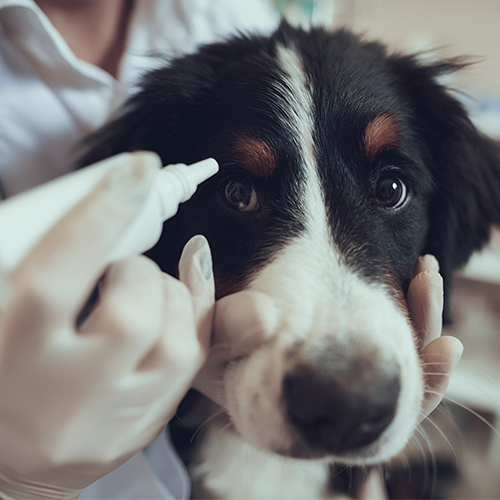Skin conditions and diseases are a common issue among dogs, identified easily by constant scratching and rashes left behind. Be sure to check your fur friend constantly for symptoms of these common skin problems that dogs might face:
Allergic reactions
Dogs can have allergic reactions to different types of environments, products, or food. Usually, a sign of allergies would be constant scratching, creating itchy rashes on your dog’s skin. To combat these allergies, you’d first have to identify the allergen: it could be an ingredient in a product or food, or something in the air. A trip to the vet would be able to help identify the allergen, and you can remove it from your pet’s life to avoid any allergic reactions in the future.
For dogs whose allergies have already been triggered, vets will be able to prescribe medication and treatment to help them feel better, and to offer the next steps to prevent further reactions.

Photo by praisaeng on Freepik.com.
Dry skin and dandruff
Another common problem would be dry and flaky skin dogs, leading to dandruff. Dogs are prone to dry skin during drastic changes in temperature, and are usually easily treated with shampoo that helps the skin to regain moisture. However, if your dog is constantly scratching, it might be an underlying problem and should be checked by a vet!
Yeast infection
Yeast tends to develop in warm areas of your dog’s body, such as their ear canals, in between toes, groin, and perineum. When a yeast infection occurs, the skin thickens and your dog will itch and bite at the infected area, causing irritated, discoloured skin.
If you spot these symptoms in your dog, a trip to the vet would allow them to prescribe you the proper medication and topical cream needed to treat the infected site and help cure the wounds.

Photo from vetericyn.com
Folliculitis
Folliculitis occurs when hair follicles get infected, causing sores, bumps and scabs on the skin. It usually appears alongside other skin conditions such as allergies and mange, and can be mitigated with shampoos and antibiotics prescribed by a veterinarian, so keep an eye out for any of these symptoms!

Photo from animalwised.com.
Impetigo
For those with puppies at home, impetigo is the bacterial infection that you should look out for. Symptoms include pus-filled blisters on the hairless portion of a puppy’s abdomen that might burst and scab over. Thankfully, impetigo is usually not too serious and can be treated with antibiotics and washes, but a vet check will help see if there are any underlying issues.

Photo from pets.webmd.com
Ringworm
Ringworm is a highly contagious disease to animals and humans alike, not caused by a worm, but by a fungal infection. On dogs, it appears as circular, crusty bald patches on the skin, often found on the head, paws, ears and forelegs. These patches lead to inflammatory skin and hair loss as the dog scratches at it, so be sure to bring your dog to the vet as soon as possible if you suspect them to have ringworm.
A vet would be able to prescribe the proper treatment to kill the fungus and prevent it from spreading to other animals and people.

Photo from arkvet.com.sg
Mange
Mange is a skin condition that’s caused by mites that live in the dog’s fur and skin. There are two types of mange, one of which is Demodetic mange, which causes scabbing, bald spots, and sores. It isn’t contagious, and can be treated by a vet.
Sarcoptic mange, on the other hand, is contagious and spreads easily among dogs. This causes intense itching, red skin, sores, and hair loss, and should be brought to a vet for immediate treatment. If your dog gets infected, be sure to wash their bedding and avoid contact with other dogs to prevent the spread of the infection.
Alopecia
Your dog can also suffer from alopecia, when poor nutrition, stress, or other underlying illness causes hair loss. This can lead to abnormal amounts of shedding and bald patches on your pet’s body, which can be treated by a veterinarian. However, hair loss is usually a symptom for other skin conditions, so keep an eye out for any other troubling signs too!

Photo from petcoach.co.
Lupus
Lupus is an autoimmune disease where the body’s own immune system attacks its own cells. This can lead to crusty skin sores that heal slowly, appearing around a dog’s nose, eyes and paws. If left untreated, it can cause kidney problems and even lead to death, so an early treatment at a vet is necessary if you suspect your dog has lupus.

Photo from animalwised.com.
Though these skin conditions might seem scary, a quick visit to a vet and the proper treatment with shampoo and medication will help make sure your dog stays safe and healthy! In the meantime, there’s no harm in keeping a look out for the signs and symptoms of these skin conditions and to take the necessary actions if you suspect that your dog is ill!
References:
https://pets.webmd.com/dogs/ss/slideshow-skin-problems-in-dogs
https://www.animaltrust.org.uk/blog/dog-skin-allergies/
https://www.purina.co.uk/articles/dogs/health/skin-fur-ears/skin-problems-and-your-dog


